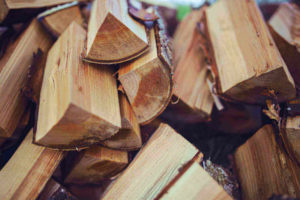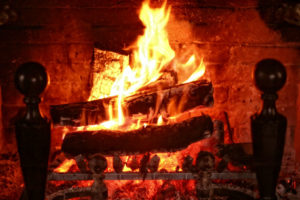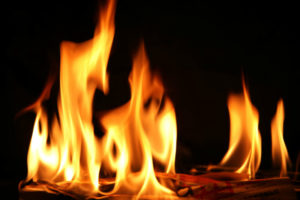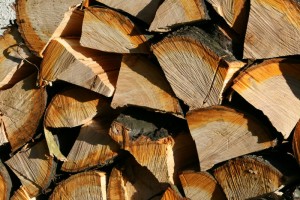Fall is here, and winter is right around the corner! As you prepare your fireplace for the burning season ahead, it is important to ensure you have the best firewood for your heating appliance. Many homeowners are surprised to learn that the firewood they use affect the safety and efficiency of their fireplaces. You have to purchase the right kind of firewood and store it correctly, these factors will improve your burning experience.
Types of firewood
 Firewood are divided into two main categories: hard woods and soft woods. Hard woods are dense, heavy. They come from trees who’s leaves change color each season. Ash, birch, maple, and oak are a few of the most popular hard woods. Hard woods make excellent firewood because they create fires that burns hotter while creating less smoke.
Firewood are divided into two main categories: hard woods and soft woods. Hard woods are dense, heavy. They come from trees who’s leaves change color each season. Ash, birch, maple, and oak are a few of the most popular hard woods. Hard woods make excellent firewood because they create fires that burns hotter while creating less smoke.
Soft woods come from evergreen trees with needles such as firs and pines. They tend to ignite quickly. This makes them ideal for kindling. However, they are known for creating large amounts of fragrant smoke, even when seasoned. This makes them ideal for outdoor firepits or when smoking meats.
Choosing the right firewood
The kind of firewood you choose often comes down to personal preference. No matter what kind of firewood you choose, it is important that the wood has been properly seasoned. Seasoned wood is wood that has been cut, stacked, and stored for at least six months to reduce the moisture content in it.
Seasoned firewood has significantly less moisture in it then freshly cut wood. Lowering the moisture content allows the firewood to ignite faster, burn hotter, and produce less smoke. Jack Pixley Chimney Sweeps and Masonry sells moisture meters. This tool shows the moisture content in seasoned firewood. Wood should have less than 20% moisture content to be burned indoors.
Drying wood in four easy steps
The EPA suggests four easy steps to correctly and easily dry your firewood.
- You must split the wood. Start by splitting large logs into uniform pieces. Having smaller logs in even sizes helps the wood dry faster.
- You need to stack them. Stack wood split side down on a dedicated firewood rack. Keep wood off the ground and away from buildings, this allows air to circulate through the wood pile and dry faster without rotting.
- You need to cover them. While the sides of the stack should remain open, cover the top of the firewood stack. This keeps moisture from rain and snow from seeping down to the stack.
- Then you need to store them properly. You need to give wood enough time to dry. Soft woods take around 6 months to dry when cut and stacked. Hard woods take upwards of 12 months before they are completely seasoned.
The kind of firewood you pick for your fireplace can really impact the efficiency and performance of your fire. This winter, make sure to burn wood that has been seasoned. For more information about seasoning firewood or purchasing a Moisture Meter, contact Jack Pixley Sweeps today!
While there are few truly wrong ways to light a fire, there are a number of fire starting techniques that can make lighting a fireplace fire easier and more efficient. Follow these five easy steps to help learn how to light your best ever fires in your fireplace this winter.
Step One
Have your fireplace swept and inspected each year. Whether you use your fireplace every day or only a few times per year, every chimney needs to be swept and inspected annually. This prevents buildup and blockages in the flue, as well as helps spot damage or deterioration before it causes major fireplace performance problems.
Step 2
Use the right firewood. The kind of firewood you use in your fires can have a major impact on fireplace performance. Firewood should be cut, stacked, and seasoned for at least a year to remove moisture content from the wood, helping it burn hotter and produce less smoke and creosote. Hardwoods such as ash, beech, cedar, maple, and oak burn hotter, more efficiently, and with less smoke; softwoods such as firs, pines, and spruces should be avoided in indoor fires. Likewise, woods from fruit trees such as cherry, apple, or plum are known for their pleasant aroma and can be used to create a pleasant smelling fire.
Step 3
Warm the flue. Before lighting even the kindling, make sure the damper is completely open. Opening the damper prevents smoke and gas from blowing back into your home. After opening the damper, there may be a rush of cold air for a few moments; if this downward draft of cold air continues for more than a few minutes, try warming the flue. Light rolled up newspaper and hold it directly below the damper. Doing this creates enough warm air to stop downdrafts without creating large amounts of smoke that can be blown back into your home.
Step 4
Start with kindling before adding wood. At the bottom of the grate, place rolled up lint, newspaper, or other fire starting aids between two large pieces of kindling wood. Create a second row of kindling lengthwise over the first stacked at a 90 degree angle; continue this until you have 3-4 rows of alternately-stacked kindling. Light the kindling from the newspaper at the bottom.
Step 5
Add logs after the kindling has ignited. Once the kindling is well-lit, begin adding firewood logs. Begin by placing 2 smaller, split logs onto the kindling; after 10 minutes, continue adding additional logs. Most smaller logs take between 5-15 minutes to burn; larger logs can burn for longer amounts of time, but also take longer to ignite. Try to add your next logs while the fire is still actively burning as adding wood on top of glowing charcoals or embers can be extremely difficult to ignite.
Contact Jack Pixley Sweeps
Following these steps to light your next fireplace fire can help ensure you have a fire that burns safer, more efficiently, longer, and with less smoke. For more information on the best way to start a fire in your fireplace, contact the chimney experts at Jack Pixley Sweeps today!
 If you have been using your fireplace for several years without incidents or problems, it can be easy to believe you are an expert. However, there are a number of burning mistakes that many homeowners are guilty of. Below are just a few of the most common burning mistakes.
If you have been using your fireplace for several years without incidents or problems, it can be easy to believe you are an expert. However, there are a number of burning mistakes that many homeowners are guilty of. Below are just a few of the most common burning mistakes.
Using the wrong firewood
Wood burning fireplaces burn best when using seasoned hardwoods. Wood that has been cut, stacked, and allowed to naturally dry has a lower moisture content, creating fires that produce less smoke, burn hotter, and leave less creosote in the flue.
Improperly storing ashes
Correct burning practices don’t end when the fire goes out; how you remove and store your ashes are also an important part of proper fireplace use. Fires should be allowed to naturally extinguish, spreading or moving the ashes periodically to prevent coals or embers from lying dormant in pockets of ash. Ashes should be removed and placed in a dedicated, metal ash container that has a lid, handle for carrying, and does not directly sit on the ground. Ashes should never be dumped into trash cans or dumpsters; ask your local trash service how to properly dispose of cool ashes in your area.
Not warming the flue
Taking a few minutes to warm the flue can reduce draft issues, especially when the temperatures outside are drastically colder than those inside the house. To warm the flue, hold a small, lit bundle of newspaper under the open damper for several minutes before igniting the main fire. Doing this warms the air in the flue and helps prevent downdrafts when the hot air from the fire begins moving up the chimney.
Burning other materials
The holidays bring plenty of excess wrapping paper, cardboard, Styrofoam, and other packing materials. While it may be tempting to burn these in your fireplace, it is not recommended; whether it is wood, gas, coal, pellets, or another fuel source, your fireplace was only built to burn one thing. In addition to releasing toxic chemicals into the air, they often burn uncontrollably and can damage your fireplace and chimney. This also includes burning pre-treated, painted, or stained wood.
Not testing smoke detectors
Smoke and carbon monoxide detectors are more than just annoying alarms whose batteries seem to run out at inopportune times. These lifesaving alarms can protect you and your family in the event of an accidental fire or leak of deadly carbon monoxide gas. Smoke and carbon monoxide detectors should be placed on every floor of the house, including near any fuel burning appliances and outside sleeping areas. Test alarms every six months and replace them every 8-10 years to ensure they continue to meet current safety and technology standards.
Avoiding chimney sweepings
Whether you use your fireplace every day during the winter or a few times during the year, it still needs to be swept and inspected at least once per year. Doing this ensures that all fireplace and chimney components are undamaged, in good condition, and safe to use.
While we may try to use our fireplaces the right way, these common burning mistakes can impact fireplace safety and performance. For more information on safe fireplace burning practices or to schedule your next chimney sweeping or inspection, contact Jack Pixley Sweeps today.
 Getting the most out of your fireplace takes more than just throwing wood and some kindling into the firebox. Starting a fire the wrong way can lead to sluggish fires that do not burn well, burn out quickly, or need to be stoked or have wood added constantly. By taking the time to correctly build a fire, you can spend less time stoking and more time enjoying it with family and friends. The following easy-to-follow tips can help you build a better fire the next time you use your fireplace!
Getting the most out of your fireplace takes more than just throwing wood and some kindling into the firebox. Starting a fire the wrong way can lead to sluggish fires that do not burn well, burn out quickly, or need to be stoked or have wood added constantly. By taking the time to correctly build a fire, you can spend less time stoking and more time enjoying it with family and friends. The following easy-to-follow tips can help you build a better fire the next time you use your fireplace!
Start a top down fire
How you stack your logs has a big impact on the quality of your fire. Top down fires minimize the need for stoking by making sure the wood gets enough oxygen as it burns. Build a top down fire by putting the largest logs on the bottom of the grate, ends facing the front and back of the firebox. Continue pyramid stacking progressively smaller and smaller logs, intertwining the stack with kindling. Ignite the top log and kindling; as the wood burns down it will naturally ignite the logs underneath it, reducing the need to add to or stoke the fire.
Warm your flue
If the weather outside is significantly colder than the temperature inside your home, warming the flue before starting a fire can reduce smoke blow-back and drafting problems. Open the damper before creating a kindling bundle of newspaper; ignite the newspaper and hold it under the open damper for several minutes – or until it burns up – to gradually warm the air temperature in the flue.
Use the right firewood
The type of firewood you use can have a major impact on the quality of your fire. For best results, seasoned hard woods should be used. Seasoned wood is made when logs are cut, stacked, and allowed to naturally dry by exposure to the elements; this reduces the moisture content in the wood and helps fires burn hotter, longer, produce less smoke, and create less creosote.
If you want to create a more aromatic fire, seasoned soft woods like cherry, pine, or fir can be used. However, soft woods often burn at a lower heat and create more smoke, making them better tailored to outdoor fire pits than indoor fireplaces. Using citrus peels as a natural kindling is an easy alternative that can add additional fragrance to your fires.
Have your chimney swept
Chimneys should be swept and inspected annually. Doing this ensures that the fireplace and flue are clean, undamaged, and safe to use. Chimney inspections can also help spot areas of damage or deterioration in the chimney and flue that may not be easily recognized by homeowners. Certified chimney sweeps can also help diagnose and repair fireplace performance problems such as drafts, odors, or leaks.
Get the most out of your fireplace this winter by following our easy burning tips. For more information on starting a good fire or to schedule your next chimney sweeping, contact Jack Pixley Sweeps today!

Proper storage of firewood can lead to better fires
While most homeowners go to great lengths to ensure that their fireplaces are properly maintained and in excellent working condition, many do not put nearly as much thought into what they’re putting into their fireplaces each season. Using the correct type of firewood – as well as wood that has been correctly seasoned and stored – can greatly improve fireplace performance and ensure that your fireplace system works well for years to come.
Firewood types
Although firewood is a generic term, each wood species has its own unique set of burning characteristics. Different species burn at different temperatures, speeds, and create varying amounts of smoke. Because of this, it is important to do research before investing in a large amount of firewood for the fall and winter.
The most popular and commonly used woods are often hardwoods. Hardwoods include species such as ash, maple, and oak, and can be identified by their broad leaves that typically change color during the fall. Hardwoods are generally preferred because they burn hotter and more steadily, producing less smoke than softwoods. However, hardwoods often light slowly, which can be a source of frustration when trying to build a warm, roaring fire.
Softwoods are typically needle-leafed trees such as firs, pines, and spruces. Because they produce more smoke when burned, softwoods are often a popular fuel for smoking meats. While their low burning temperature makes them somewhat less popular for fires, their ability to ignite quickly makes softwoods an ideal source for kindling. A prime example of this is using softwood kindling for a fire with hardwood logs.
Firewood seasoning
No matter what species of type of wood is being used, it is vitally important that the wood has been properly seasoned. Seasoned firewood is wood that has been chopped, stored, and exposed to the sun for at least 6 to 12 months. Doing this removes the moisture from the wood, allowing it to burn more efficiently and with less smoke. Wood that has not been properly seasoned will typically be hard to ignite and hiss while being burned due to the high water content in the wood.
Firewood that has been suitably seasoned will be lighter and less dense than freshly-cut wood, and banging two dried pieces together should produce a hollow, rather than dull, sound. Likewise, seasoned wood will often have cracked or split ends, indicating that the majority of the moisture has left the wood.
Firewood storage
While firewood should be exposed to sun and wind during the summer for seasoning, it needs to be protected from rain and snow during the winter. A cover, roof, or tarp can be used to protect a firewood pile and prevent snow from building up on the stack; however, whenever possible, the sides should remain open to allow air flow in the wood. This allows the seasoning process to continue and prevents a buildup of moisture. Likewise, wood should be stored off the ground to keep the bottom layer of wood dry, prevent rotting, and avoid insect infestation.
When bringing wood inside for use, only carry as much as you will immediately need. Firewood that is stored for long periods of time at room temperature can cause any dormant bugs in the wood to be become active.
 Firewood are divided into two main categories: hard woods and soft woods. Hard woods are dense, heavy. They come from trees who’s leaves change color each season. Ash, birch, maple, and oak are a few of the most popular hard woods. Hard woods make excellent firewood because they create fires that burns hotter while creating less smoke.
Firewood are divided into two main categories: hard woods and soft woods. Hard woods are dense, heavy. They come from trees who’s leaves change color each season. Ash, birch, maple, and oak are a few of the most popular hard woods. Hard woods make excellent firewood because they create fires that burns hotter while creating less smoke.
 If you have been using your fireplace for several years without incidents or problems, it can be easy to believe you are an expert. However, there are a number of burning mistakes that many homeowners are guilty of. Below are just a few of the most common burning mistakes.
If you have been using your fireplace for several years without incidents or problems, it can be easy to believe you are an expert. However, there are a number of burning mistakes that many homeowners are guilty of. Below are just a few of the most common burning mistakes. Getting the most out of your fireplace takes more than just throwing wood and some kindling into the firebox. Starting a fire the wrong way can lead to sluggish fires that do not burn well, burn out quickly, or need to be stoked or have wood added constantly. By taking the time to correctly build a fire, you can spend less time stoking and more time enjoying it with family and friends. The following easy-to-follow tips can help you build a better fire the next time you use your fireplace!
Getting the most out of your fireplace takes more than just throwing wood and some kindling into the firebox. Starting a fire the wrong way can lead to sluggish fires that do not burn well, burn out quickly, or need to be stoked or have wood added constantly. By taking the time to correctly build a fire, you can spend less time stoking and more time enjoying it with family and friends. The following easy-to-follow tips can help you build a better fire the next time you use your fireplace!